Lost Forests
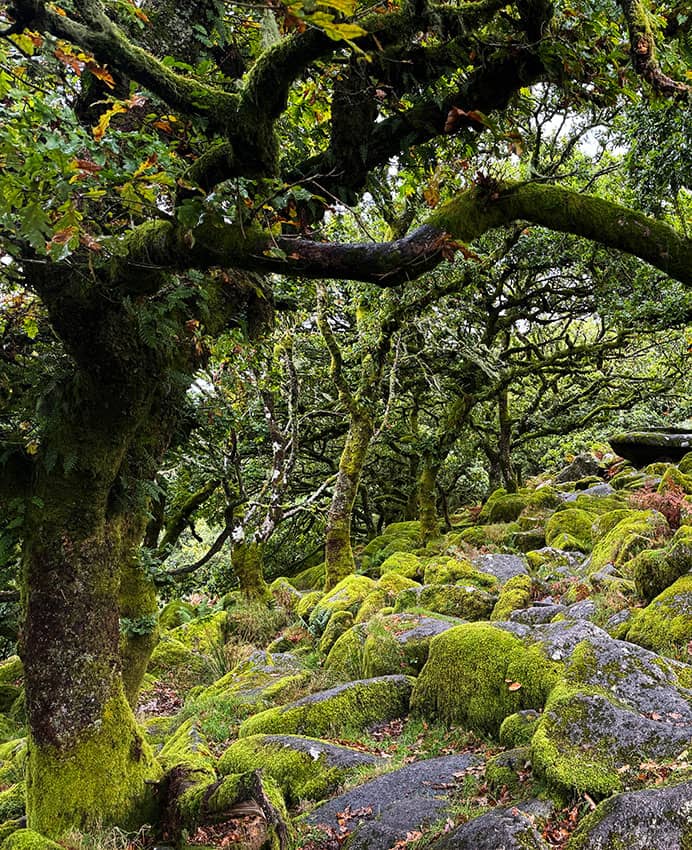
Drawing inspiration from indigenous forests, ancient landscapes, and ever-changing coastlines, NVW’s work, Lost Forests, invites both viewer and wearer to reappraise the wilds of Britain. Natasha Wightman’s choice to use rare and ancient bog oak in her designs for Lost Forests, led to a fortuitous journey of discovery into Britain’s temperate rainforests. Wightman believes that the tiny fragile fragments of temperate rainforest that cling on in Britain today are treasure troves that need to be protected, understood and appreciated, just as Britain’s heritage crafts are in need of expansion and recognition.
At the heart of this series lies Hemplands Haul bog wood, sub-fossilised remnants of mighty oaks from East Anglia’s Neolithic forests, submerged by rising seas and hostile weather conditions. A testimony to forests long gone, the bog oak was preserved in earthen silence for over 4800 years, before emerging as a reminder of wildness forgotten. This exceptional material, regarded as Britain’s finest carving medium, carries within its dense, dark grain the story of a lost ecosystem. The bog oak represents both permanence and profound change, as Britain’s memory in material form.
Wightman transforms the narrative by pushing boundaries and combining a contemporary vision with historic craft. Working with master carver Graham Heeley, the sculpted works of art provide a window to how these ancient mountains, forests and coves continue to look after thousands of years. From millennia-old stories woven into the Lost Forest pieces, a body of work has emerged, comprising jewellery, sculpture, film, a documentary, and a dance interpretation inspired by the works.
Today, only 1% of Britain’s rainforests remain. Wightman’s hope is that in rendering these special habitats in the sub-fossilised bog oak, the echo of Britain’s once abundant forests, it will compel the viewer and the wearer to consider our attitudes towards today’s habitats and landscapes.
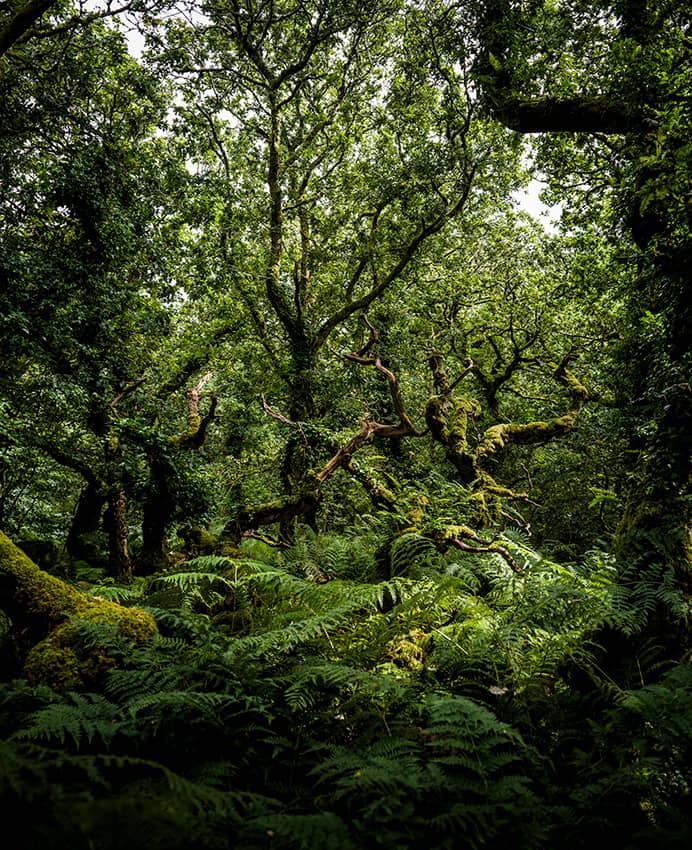
Jewellery
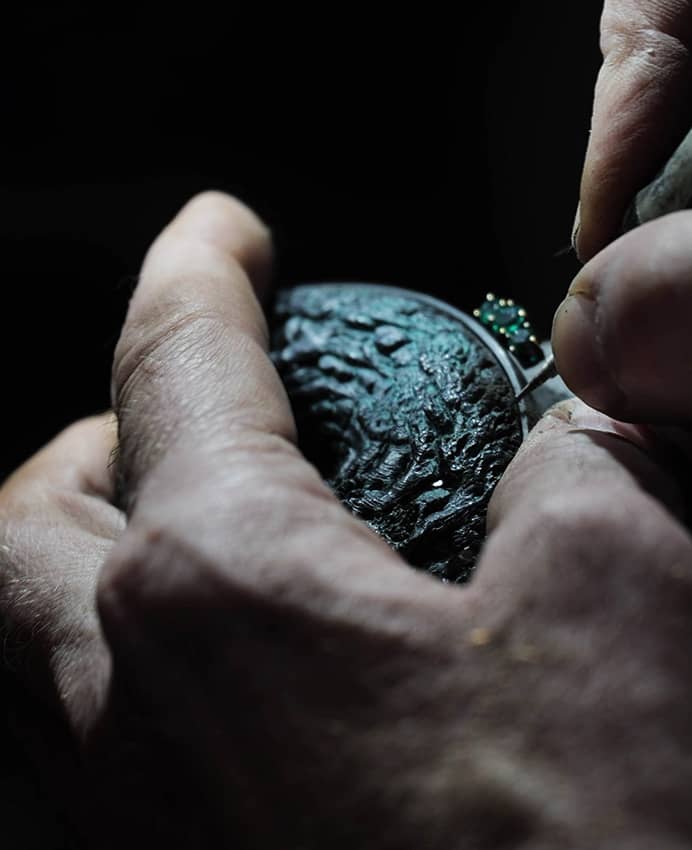
The thematic core of this series is defined by bold, organic forms with intricate detailing. The striking mandorla shape of each one-of-a-kind piece symbolises the intersection of ancient and modern, craftsmanship and nature. The master carver has meticulously sculpted these miniature works of art, giving more visibility to the last of our indigenous landscapes, stretching from Snowdonia to Dartmoor. Substantial cuffs, earrings, and pendants that convert to brooches, provide a canvas for fine relief carving, while handmade chains and precisely set diamonds, emeralds and sapphires echo the delicate interplay of light and nature. This visual dialogue between strength and fragility reflects NVW’s thematic exploration of endurance and vulnerability in nature, compelling the viewer and the wearer to consider our environments, connecting them to a deep environmental history.
“Jewellery creates an intimate relationship between ancient stories and contemporary life. When someone wears a piece from Lost Forests, they’re carrying a fragment of Britain’s lost rainforests with them and it becomes a daily reminder of both what we’ve lost and what we still need to protect. Just as the viewer of a painting is a part of its meaning and interpretation, with this work there is an interplay between the piece and the wearer that I find incredibly compelling.”
Natasha Wightman
Film
The immersive film, directed by Wightman, transports viewers into the very environments that inspired the Lost Forests series, creating a multi-sensory, multi-dimensional experience. Through carefully layered imagery, the film weaves together Britain’s ancient landscapes with intricate details of the jewellery. The blackness of carved bog oak and the glint of precious stones merge with windswept moors, thundering Atlantic waters and the timeless still of the glaciated valley.
Sound artist Kate Fleur Young’s original composition forms the film’s backbone, layering authentic environmental soundscapes, moorland winds, ocean waves and birdsong, with organically orchestrated vocals. This sonic landscape envelopes the viewer, taking them to Britain’s wild territories.
The film becomes a sensory bridge between NVW’s miniature carved worlds and the monumental landscapes they represent, enveloping viewers and transporting them to the grandeur of Britain’s lost forests.
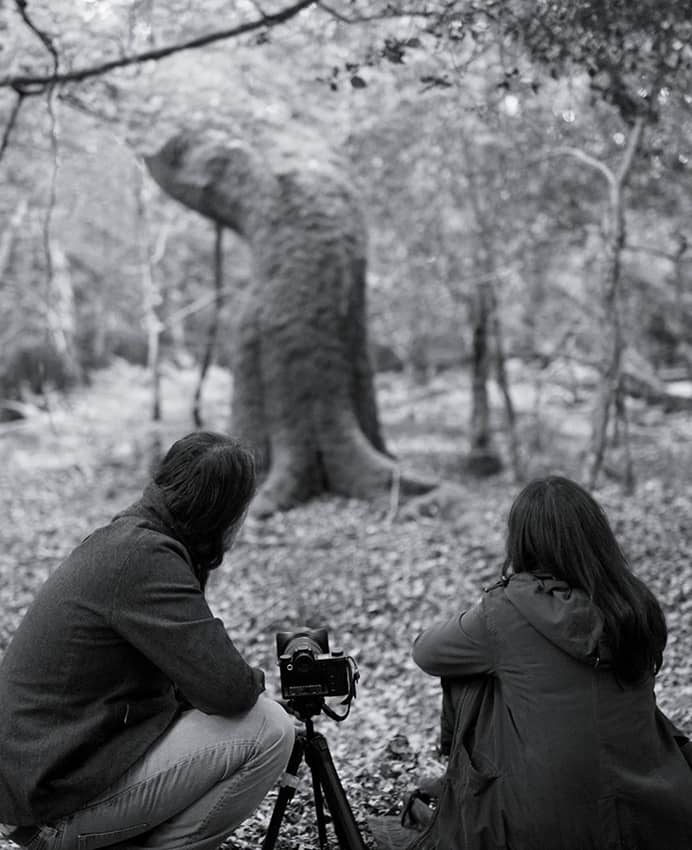
Performance
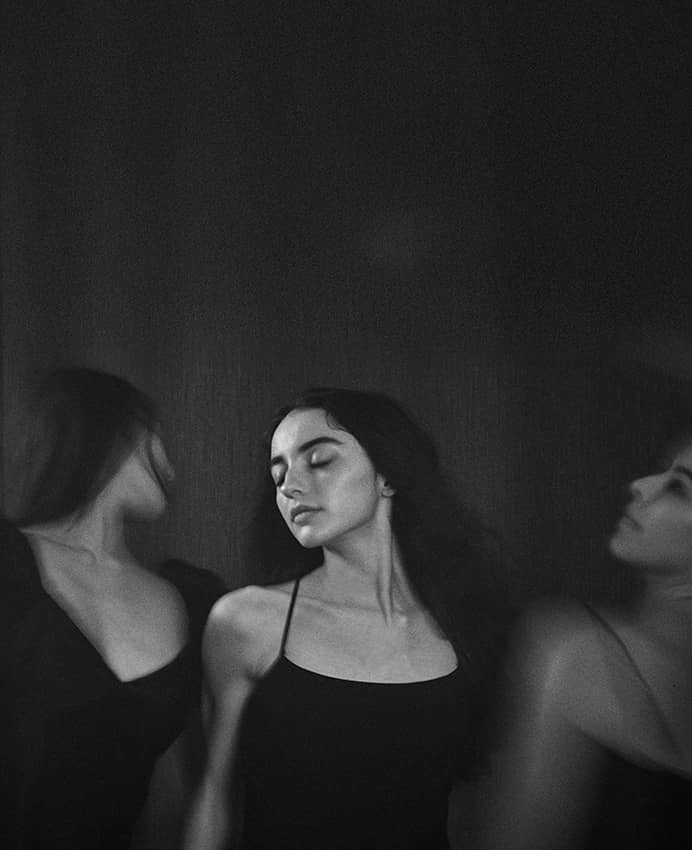
Inspired by the works, the Lost Forests dance interpretation extends NVW’s exploration beyond material into movement, conveying the forces of nature through live choreography. Directed by Natasha Wightman, this unique collaboration features professional dancers, choreographed by ex Royal Ballet dancer Nathalie Harrison. The performance is accompanied by an original composition by orchestrator Rachel Fuller, who has worked with, amongst others, The Royal Philharmonic Orchestra, The London Oriana Choir and The London Chamber Orchestra.
Just as Wightman draws deliberate connections between rare materials and rare craftsmanship in her jewellery, she has assembled artists at the apex of their disciplines to celebrate rarefied British craft in all its forms. The interpretation is a living meditation on the themes that define the Lost Forests series, the dialogue between permanence and transience, strength and fragility, ancient memory and present witness.
The performance stands as testament to the enduring power of traditional British artistry, where exceptional skill transforms ancient stories into contemporary expression.
Materials
The materials for Lost Forests form the cornerstone of its conceptual framework. Central to each piece is sub-fossilised bog oak, silent witnesses to Britain’s ancient rainforests that disappeared beneath rising tides millennia ago. This rare and prized material, with its deep ebony tones and remarkable preservation, represents both permanence and profound change. Bog oak is an extremely challenging material to master and requires specialised knowledge, diligence and craftsmanship. Wightman’s decision to highlight ancient wood with shell gold and natural malachite pigment, and pair them with precious metals and gems, creates a meaningful dialogue between materials. Black ruthenium plated sterling silver, 18k gold and platinum settings provide luminous contrast to the bog oak’s depth, while diamonds, emeralds and sapphires introduce elements of light and colour – like dappled sunlight filtering through forest canopies and ocean spray frozen in time.
Each material component undergoes transformation through traditional craftsmanship. The master carver reveals the bog oak’s character through micro craving and relief techniques that capture organic forms with extraordinary precision. The master goldsmiths create bespoke settings that complement rather than overwhelm the bog oak’s narrative significance. This thoughtful material selection reinforces the collection’s thematic core, celebrating what remains of Britain’s natural environments whilst acknowledging what has been lost, and what might yet be saved through renewed appreciation and conservation efforts.
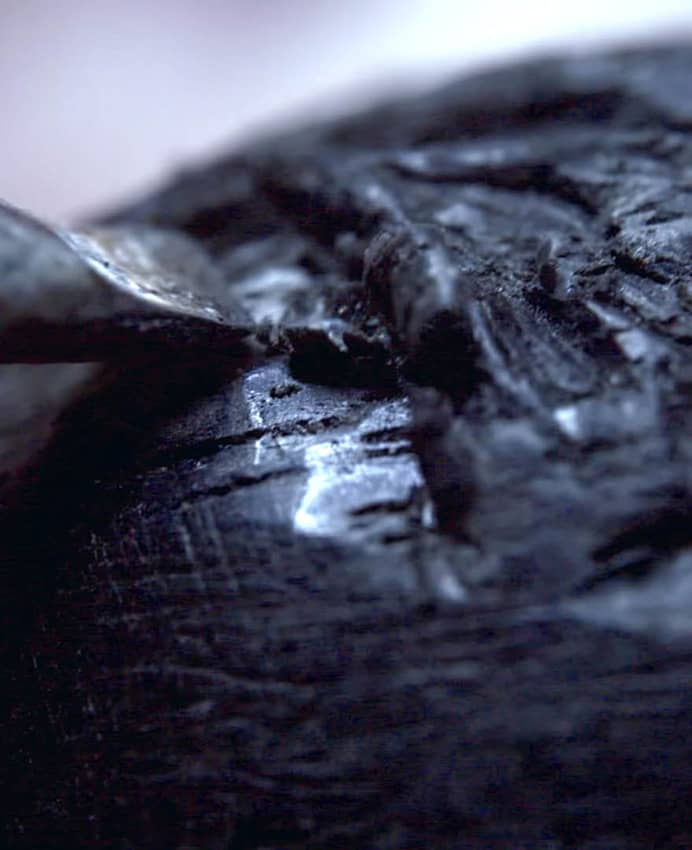
The Hemplands Haul
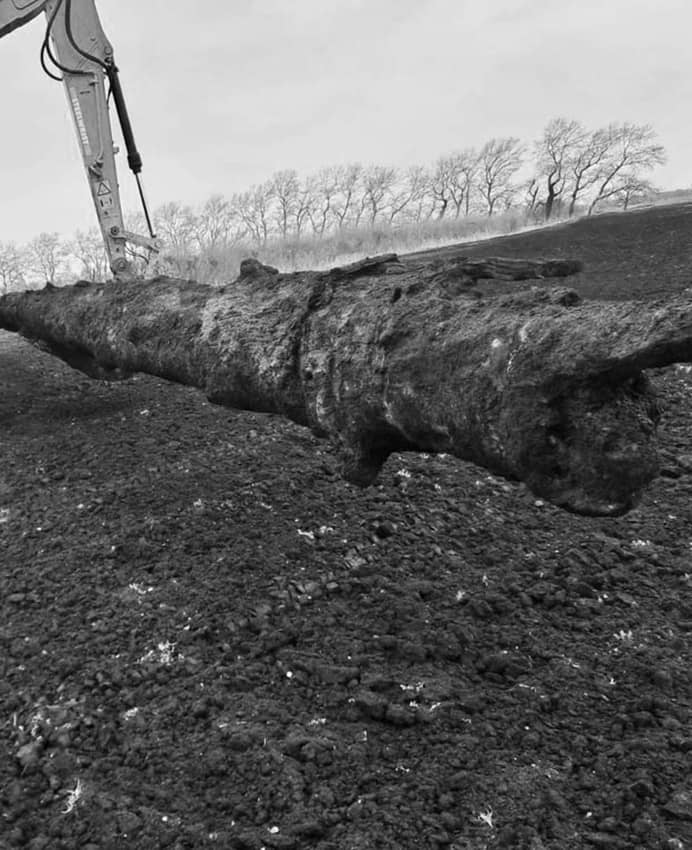
The materials for Lost Forests form the cornerstone of its conceptual framework. Central to each piece is sub-fossilised bog oak, silent witnesses to Britain’s ancient rainforests that disappeared beneath rising tides millennia ago. This rare and prized material, with its deep ebony tones and remarkable preservation, represents both permanence and profound change. Bog oak is an extremely challenging material to master and requires specialised knowledge, diligence and craftsmanship. Wightman’s decision to highlight ancient wood with shell gold and natural malachite pigment, and pair them with precious metals and gems, creates a meaningful dialogue between materials. Black ruthenium plated sterling silver, 18k gold and platinum settings provide luminous contrast to the bog oak’s depth, while diamonds, emeralds and sapphires introduce elements of light and colour – like dappled sunlight filtering through forest canopies and ocean spray frozen in time.
Each material component undergoes transformation through traditional craftsmanship. The master carver reveals the bog oak’s character through micro craving and relief techniques that capture organic forms with extraordinary precision. The master goldsmiths create bespoke settings that complement rather than overwhelm the bog oak’s narrative significance. This thoughtful material selection reinforces the collection’s thematic core, celebrating what remains of Britain’s natural environments whilst acknowledging what has been lost, and what might yet be saved through renewed appreciation and conservation efforts.
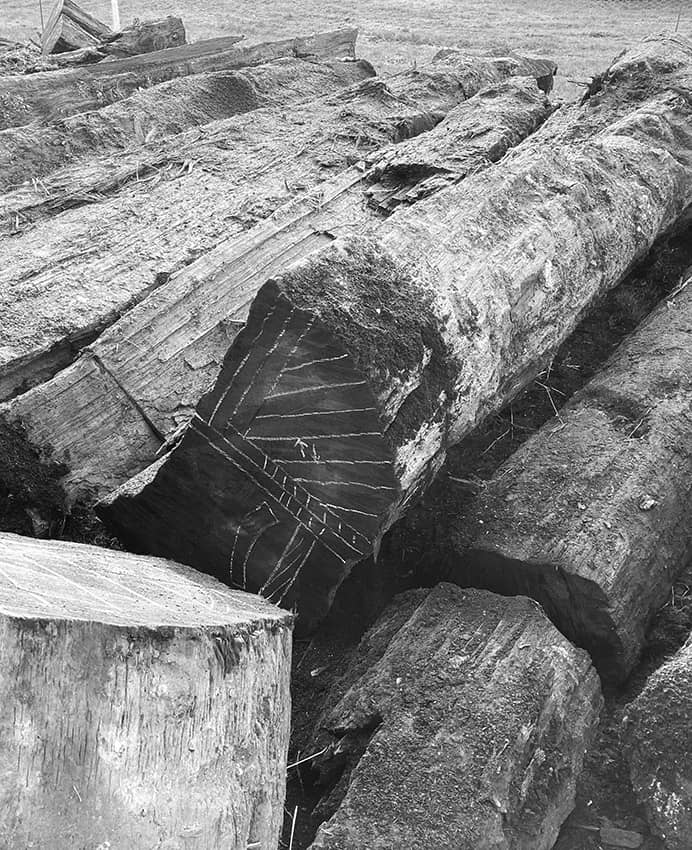
Portraits and Photography
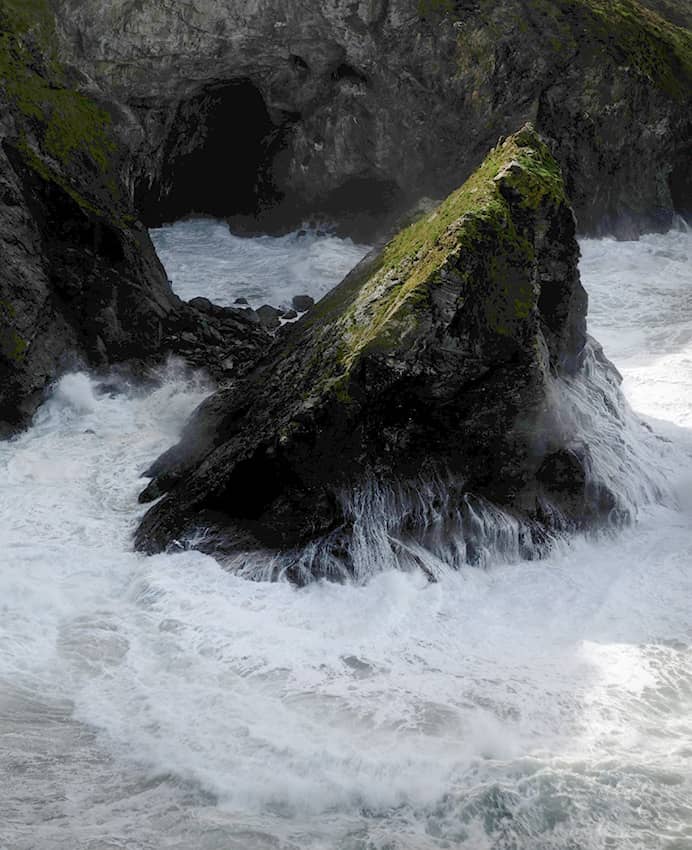
The Lost Forests collection deliberately platforms individuals who are actively working to protect British wildlife. This compelling series of portraits features leading British ecologists, including Erinna Miles, a bioscientist, conservationist, speaker and environmentalist, and Dr Mya-Rose Craig, an ornithologist, founder of Black2Nature, environmental campaigner, author and speaker. These inspiring young leaders are devoted to protecting and preserving British wildlife for future generations. Wightman’s invitation to the ecologists to be photographed wearing Lost Forests, highlights her aspiration to bring attention to their work and our fragile contemporary habitats facing mounting environmental pressures.
Fine art photographer Tessa Traeger, known for her profound exploration of still life and landscape, has captured the pieces against the landscapes that inspired the work, highlighting the beauty and rawness of the British Isles.
The landscape photography, captured by Thomas Birkett, honours both the strength and the fragility of Britain’s coastlines, mountains, and forests. From the wide, wind-swept skies of Dartmoor to the snow-covered heights of the Scottish Highlands, from Cornwall’s restless shores to secret waterfalls nestled beneath our loftiest peaks, Wightman’s journey traces what shifts and what endures within Britain’s natural world.
